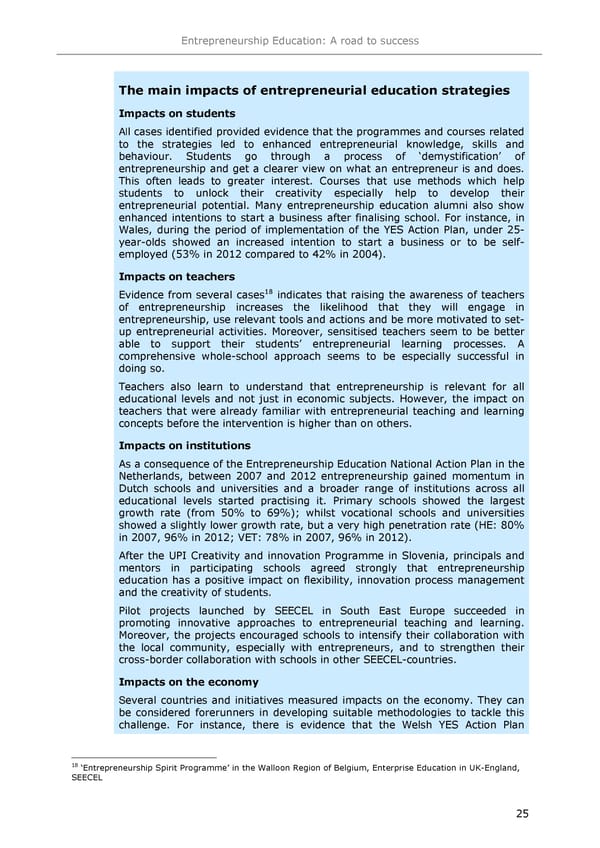Entrepreneurship Education: A road to success The main impacts of entrepreneurial education strategies Impacts on students All cases identified provided evidence that the programmes and courses related to the strategies led to enhanced entrepreneurial knowledge, skills and behaviour. Students go through a process of 8demystification9 of entrepreneurship and get a clearer view on what an entrepreneur is and does. This often leads to greater interest. Courses that use methods which help students to unlock their creativity especially help to develop their entrepreneurial potential. Many entrepreneurship education alumni also show enhanced intentions to start a business after finalising school. For instance, in Wales, during the period of implementation of the YES Action Plan, under 25- year-olds showed an increased intention to start a business or to be self- employed (53% in 2012 compared to 42% in 2004). Impacts on teachers 18 Evidence from several cases indicates that raising the awareness of teachers of entrepreneurship increases the likelihood that they will engage in entrepreneurship, use relevant tools and actions and be more motivated to set- up entrepreneurial activities. Moreover, sensitised teachers seem to be better able to support their students9 entrepreneurial learning processes. A comprehensive whole-school approach seems to be especially successful in doing so. Teachers also learn to understand that entrepreneurship is relevant for all educational levels and not just in economic subjects. However, the impact on teachers that were already familiar with entrepreneurial teaching and learning concepts before the intervention is higher than on others. Impacts on institutions As a consequence of the Entrepreneurship Education National Action Plan in the Netherlands, between 2007 and 2012 entrepreneurship gained momentum in Dutch schools and universities and a broader range of institutions across all educational levels started practising it. Primary schools showed the largest growth rate (from 50% to 69%); whilst vocational schools and universities showed a slightly lower growth rate, but a very high penetration rate (HE: 80% in 2007, 96% in 2012; VET: 78% in 2007, 96% in 2012). After the UPI Creativity and innovation Programme in Slovenia, principals and mentors in participating schools agreed strongly that entrepreneurship education has a positive impact on flexibility, innovation process management and the creativity of students. Pilot projects launched by SEECEL in South East Europe succeeded in promoting innovative approaches to entrepreneurial teaching and learning. Moreover, the projects encouraged schools to intensify their collaboration with the local community, especially with entrepreneurs, and to strengthen their cross-border collaboration with schools in other SEECEL-countries. Impacts on the economy Several countries and initiatives measured impacts on the economy. They can be considered forerunners in developing suitable methodologies to tackle this challenge. For instance, there is evidence that the Welsh YES Action Plan 18 8Entrepreneurship Spirit Programme9 in the Walloon Region of Belgium, Enterprise Education in UK-England, SEECEL 25
 Entrepreneurship Education Page 28 Page 30
Entrepreneurship Education Page 28 Page 30